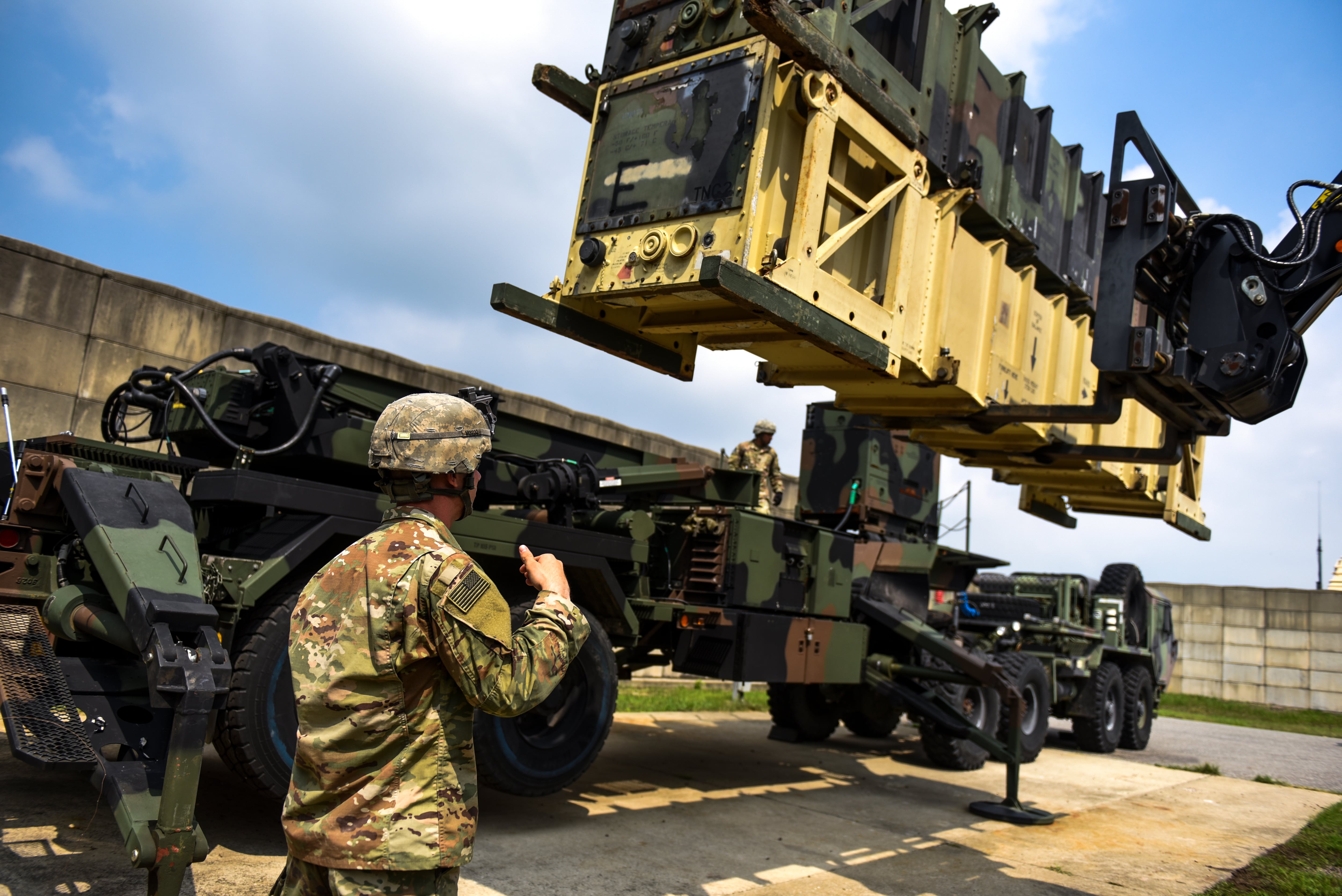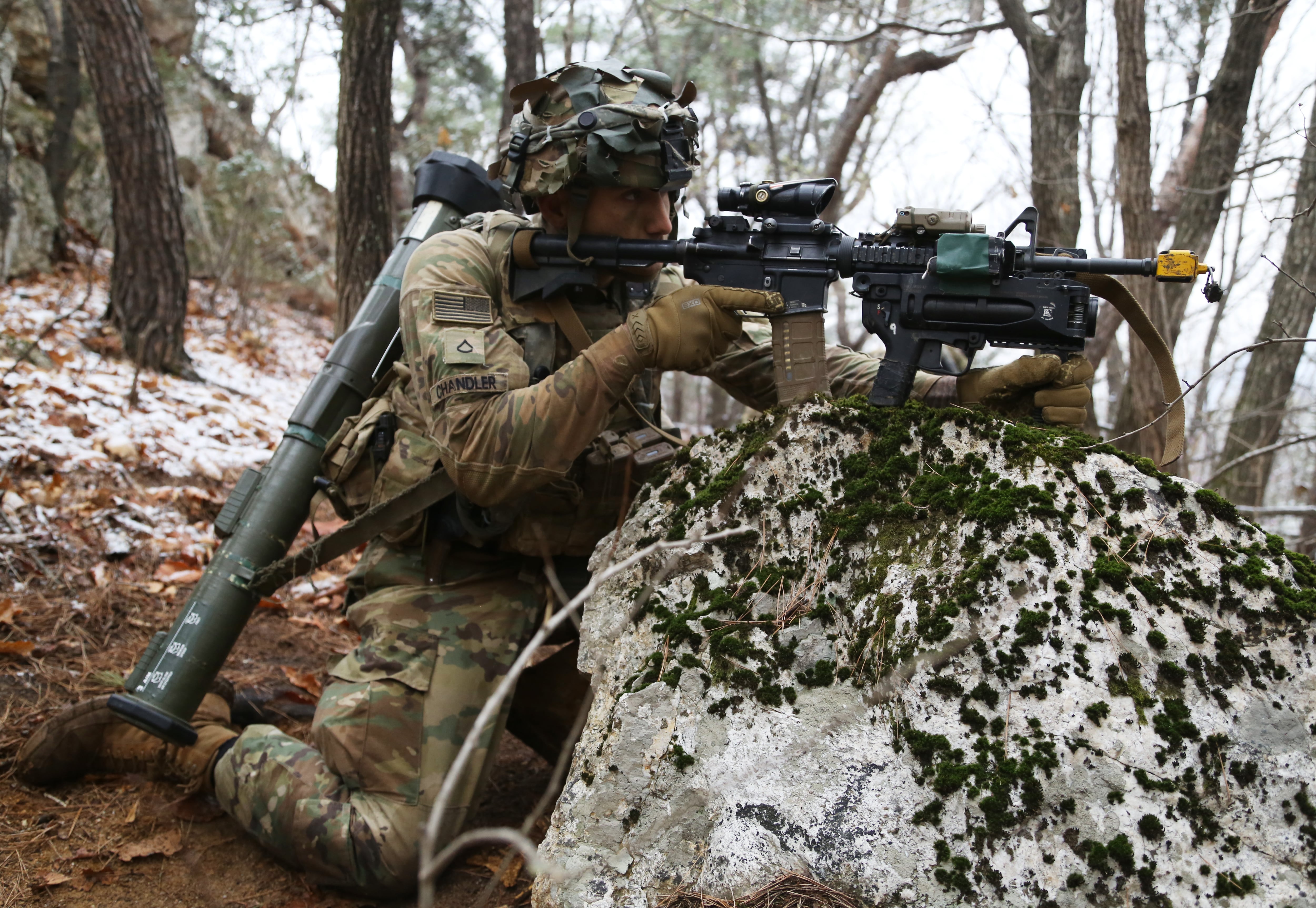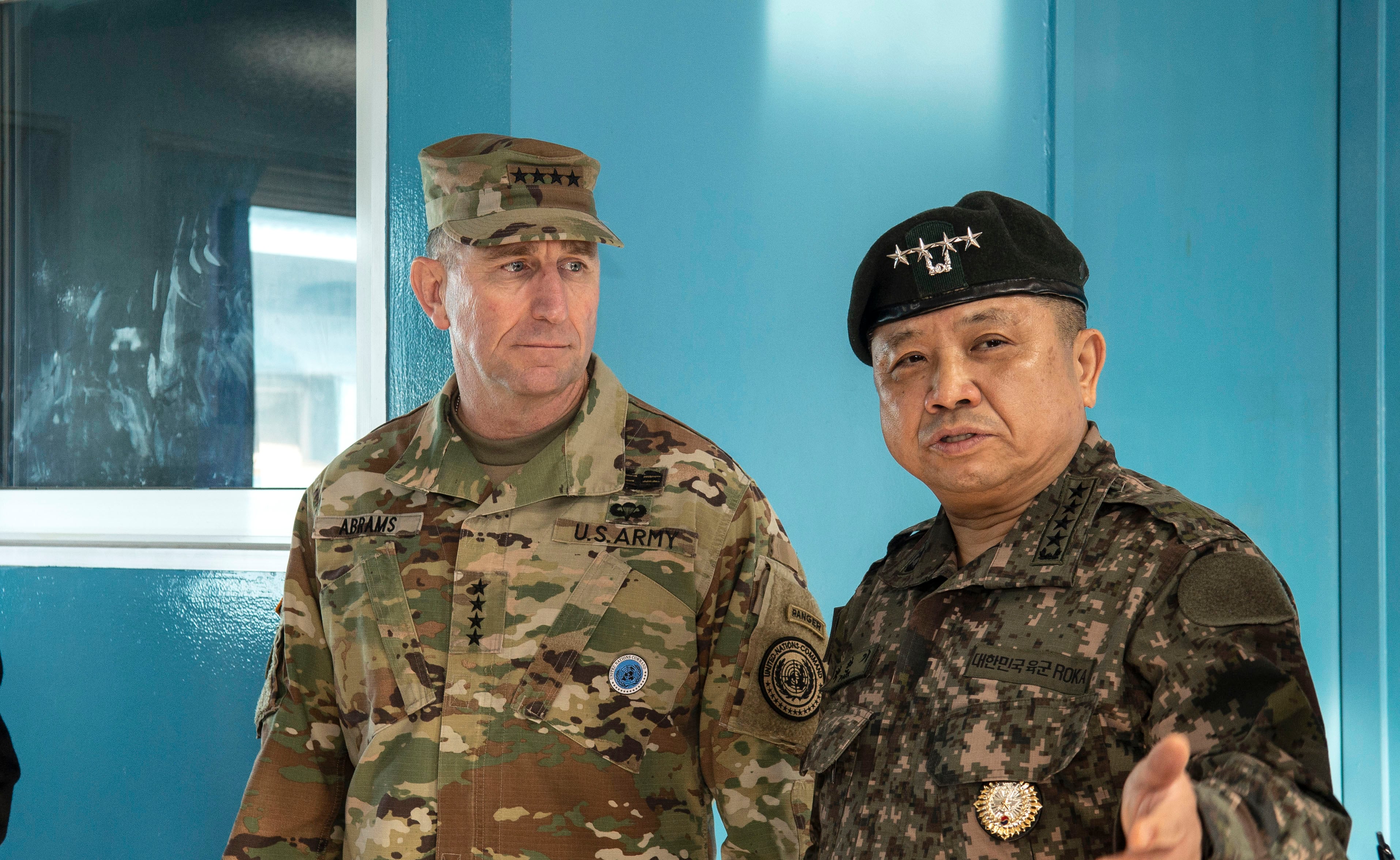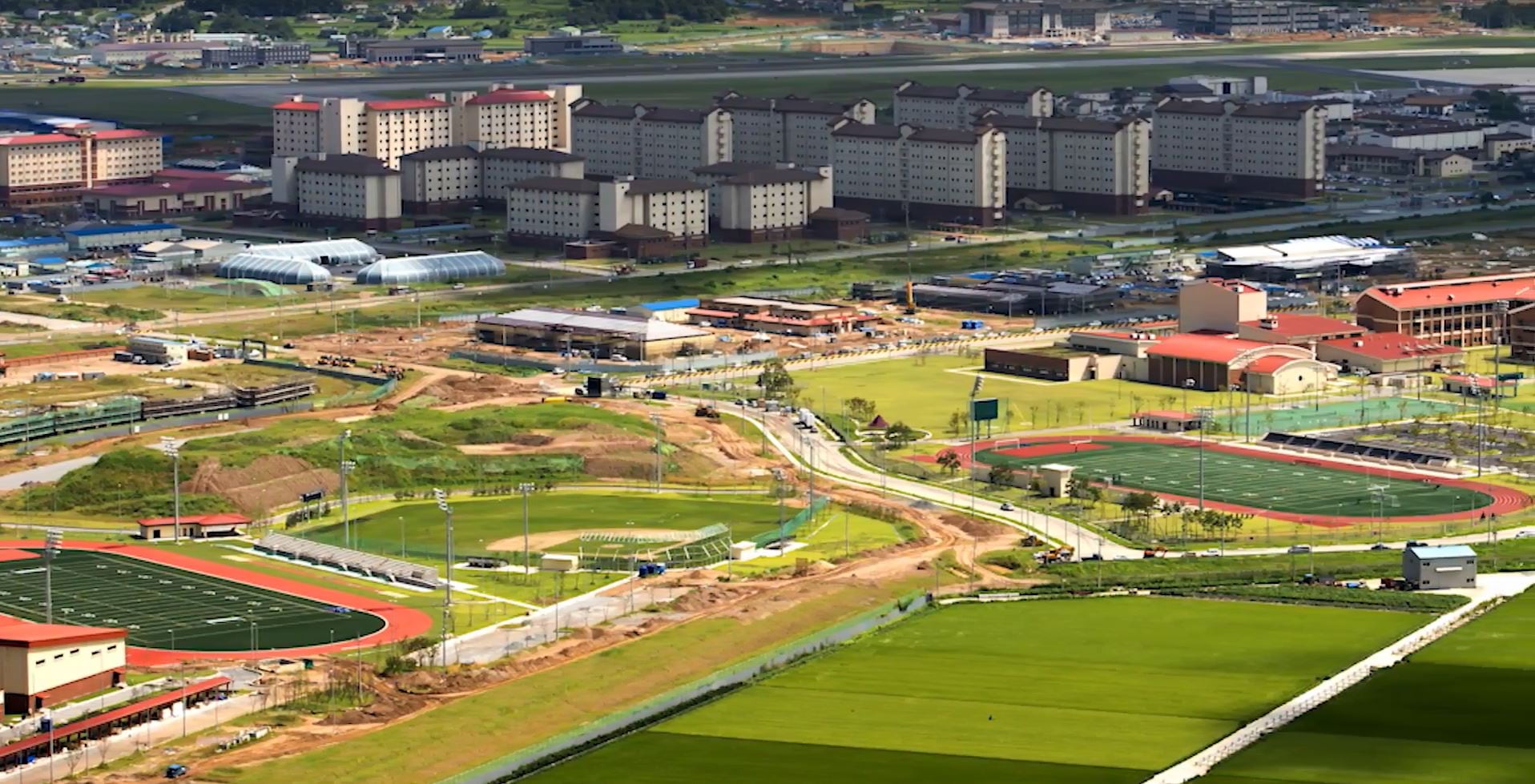Soldiers on the Korean Peninsula are in the final stages of a relocation plan that consolidates U.S. forces at a new hub south of Seoul, in an area North Korea appears to have labeled a “fat target" for its new weapons.
Now the largest U.S. base overseas, the Army’s Camp Humphreys has been built up in the last decade in part to put distance between U.S. soldiers and the North Korean artillery sighted in on their long-time home of Yongsan Garrison in downtown Seoul.
But since the relocation plan was set in motion, North Korea has developed large caliber rockets and ballistic missiles, as well as a nuclear capability, likely capable of reaching the expanded base 40 miles south of Seoul, the capital of South Korea.
The new location’s distance from Seoul also raises concerns about training for the U.S. soldiers in South Korea. Many of them will now be much further from the maneuver and live-fire ranges that are close to the demilitarized zone.
The move will also complicate face-to-face communication between U.S. commanders and their counterparts, which is considered crucial for operations during a crisis there.
American forces will have largely vacated Yongsan Garrison by December, relocating to the $11 billion, 3,500-acre base that was mostly funded by South Korea.
More than 35,000 soldiers, civilians and family members will eventually populate Camp Humphreys, which has seen a massive expansion near the western port city of Pyeongtaek.
It’s the largest construction and transformation project in U.S. Defense Department history and potentially the Army’s most important point of power projection in the Pacific region.
Still in lethal range
As Camp Humphreys grew over the past decade, North Korean weapons advanced as well, giving the North’s forces greater range to reach across the Korean Peninsula.
“If you pay attention to the North Korean propaganda, in July, they said they’ve been developing these weapons to be able to strike a ‘fat target’ in South Korea, and we assume that the ‘fat target’ is Camp Humphreys, as well as Osan Air Base, which is in close proximity," said retired Army Col. David Maxwell, a senior fellow at the Foundation for Defense of Democracies think tank who has two decades of military service in Asia.
“So while we may be out of short-range artillery, North Korea has developed weapon systems in response to our relocation," Maxwell told Army Times. “We have pretty much consolidated the majority of combat forces at Camp Humphreys and that sure looks like a ‘fat target.'”
North Korea’s 300 mm multiple rocket launcher and KN-23 short-range ballistic missile both have an advertised capability to reach Camp Humphreys.
Cheongju Air Base, where the R.O.K’s new F-35 aircraft are reportedly located, is also a short distance further southeast, and within that threat bubble.
Before the transition further south, American forces were more dispersed along the DMZ and at multiple camps throughout the country. The consolidation takes away that perceived advantage.
Bruce Bennett, a senior defense researcher at the Rand Corp. think tank, agrees that consolidating on Camp Humphreys now gives North Korea a fairly easy target.
The regime’s KN-23 missile, which was tested this summer, appears to resemble the Russian Iskander missile and “might evade a Patriot intercept,” Bennett said.
To be sure, the U.S. Army has Patriot missile batteries and Terminal High Altitude Area Defense systems overseeing its foothold in the region. South Korean surface-to-air counter measures also exist, and the R.O.K military has a network of early warning systems, though it may require a redesign to defeat North Korea’s newest weapons, Shin Won-shik, a former vice chairman of South Korea’s Joint Chiefs of Staff, told Defense News in May.

Adding nuclear weapons into the mix increases the potential damage a first strike would deal to a condensed American presence. A nuclear bomb with a 250-kiloton yield, the estimated size of North Korea’s sixth nuclear test, would be capable of mostly engulfing Camp Humphreys, Bennett explained.
“So one shot allows Kim [Jong-un] to get his objective. Of course, as a result he would almost certainly be killed by the U.S., but Kim doesn’t seem to expect that," Bennett said, referring to the North Korean leader.
“North Korea threatened that Pyeongtaek is ‘our military’s foremost strike target,’" according to a report by the Korea Institute for Defense Analyses, a think tank funded by the R.O.K government, published in October 2017.
“Such strong response from North Korea indicates that North Korea perceives Camp Humphreys as a grave threat,” the report reads.
The size and scale of Camp Humphreys worries North Korea, the report says, as it represents a stable, long-term presence of U.S. troops on the peninsula that can better receive large flows of forces during a crisis.
Some assume the Kim regime wouldn’t dare to attack the U.S. presence in South Korea, as it would certainly face a retaliatory strike.
But a senior North Korean military defector disagreed with that.
“If a war breaks out in the Korean Peninsula, the North’s main target will be the U.S. forces based in the South and Japan," he said in congressional testimony in 1997, saying that is why Kim Jong-un’s father, Kim Il-Sung, worked furiously on missile programs. The elder Kim believed that if North Korea creates more than 20,000 American casualties in the region, U.S. political leaders would concede defeat, according to the defector.
That view likely still exists under Kim Jong-Un, according to Bennett. “I had heard a similar argument from a more senior military defector about [two] years ago — he defected under Kim Jong-un.”
Talks between President Donald Trump and Kim Jong-un aimed at denuclearization and decreasing tensions on the Korean peninsula have been mostly stalled since a February summit.
‘No places to train’
The problem with massing soldiers at Camp Humphreys is “there’s no places to train,” said Rick Lamb, a retired Army Green Beret command sergeant major who first served in South Korea in the mid-1980s as a young soldier. He went back roughly three decades later to serve as a civilian adviser to Special Operations Command-Korea until 2017.
“You have to travel north," Lamb added. “It’s kind of like how it is in Germany now ... you have to go all the way to Hohenfels Training Area” to train.
The distance from Camp Humphreys to the soldiers’ training areas will create logistics issues and adjustment challenges for them.
“This is the real challenge with moving to Camp Humphreys because most of the training areas are still up at the DMZ," Maxwell said. “So they have to go Rodriguez Range to be able to conduct large-scale live-fire training.”
Soldiers can shoot small arms at some of the gunnery ranges at Camp Humphreys, “but large-scale maneuver training, they still have to return back up to the front line areas where the training areas exist," Maxwell said.
To do that, soldiers have to use a rail head because they can’t convoy U.S. forces by ground through the densely populated region.

A spokeswoman for U.S. Forces Korea would not comment. Any news stories regarding exercises, training, ranges and crisis response “are extremely sensitive on the Korean Peninsula right now,” said spokeswoman Jacqueline Leeker.
“Stories about those topics tend to get the immediate attention of North Korea, can increase tension and directly impact diplomatic efforts,” she told Army Times.
Face-to-face in crises
The distance between Camp Humphreys and Seoul may not look very far on a map, but it is complicated by urban congestion and traffic.
That has implications for South Korea’s wartime planning, which is heavily linked to the senior U.S. military commander. Prior to the relocation to Camp Humphreys, American planners were located in Seoul, alongside all the necessary R.O.K military commanders.
“The proximity there allowed him to have easy face-to-face meetings with the chairman of the R.O.K joint chiefs of staff and that was very important in crisis action,” said Maxwell, who served as the chief of staff for Special Operations Command-Korea and on the operations staff for the peninsula’s Combined Forces Command and U.S. Forces Korea.
“I’ve been through a number of crises with the submarine infiltration, things that have happened over the years,” he added. “And that proximity made it easy. ... For us action officers, we could walk from the CFC headquarters to the R.O.K Ministry of Defense and R.O.K [joint chiefs], and it was pretty easy to coordinate.”
Combined Forces Command, or CFC, is the warfighting headquarters for U.S. and R.O.K militaries. It will move in total down to Camp Humphreys, despite fears this summer that it would be split.
But that still leaves the R.O.K joint chiefs of staff and the R.O.K Ministry of Defense in Seoul.
It sounds like a mundane problem in the digital age, when various forms of communication can offer near-instant coordination to respond to any contingency. But during international crises, face-to-face coordination is more crucial, especially with a language barrier like that between Korean and English.

“You have to use a translator and that complicates things," Maxwell said. "Having a translator while you’re talking face-to-face is not a big issue but when you’re talking over the phone or by email, if your English or your Korean skills are not equal, that poses some communications challenges.”
“Proximity helps reduce that communications friction," he added.
Historically, it has been critical to have all these players collocated with the CFC personnel, said Bennett. By comparison, the separation between the U.S. Department of Defense and its geographic combatant commands is one that U.S. personnel are used to “but that has previously not been the case for the R.O.K,” Bennett said.
“So they will face some struggles and adjustments in relationships and decision making,” he added.
A sometimes scandalous presence
South Korea paid for an estimated 90 percent of the costs to build Camp Humphreys, and there’s good reason for that. The move south reduces R.O.K concerns about having foreign military forces inside their capital, “which is good for political purposes," Bennett said.
The presence of U.S. troops has not been without friction. U.S. service members have been long-subjected to curfews to curb misbehavior. The area surrounding Yongsan Garrison has in the past had a sordid reputation, due in part to prostitution that served U.S. soldiers.
The area’s reputation has improved, but the presence of the Americans has nevertheless been a hot-button issue, especially given the real estate value of the land that will be turned over.
“What’s really driving this is domestic politics in Korea that goes back to 2003," Maxwell said.
At that time, Defense Secretary Donald Rumsfeld began setting into motion the plan that would have U.S. forces depart Yongsan more than a decade later.

Yongsan Garrison is right in the middle of Seoul, which “impacts the perception of South Korean sovereignty," Maxwell said.
“We’ve had plans going back at least to the 1980s to move Yongsan out of Seoul," he added. "There have been different plans over the years, but they were not really put into motion until 2003 and 2004, and now we’re seeing the culmination.”
Still, the majority of South Koreans do support a lasting U.S. troop presence outside their capital, according to a January 2019 poll by the Seoul-based Asian Institute for Policy Studies.
New American outpost
For Americans stationed in South Korea, the experience of being based in the metropolis of Seoul was unmatched.
For U.S. soldiers, Camp Humphreys could be a much more insular duty assignment than being in Seoul. Its size and amenities make it a home away from home for Americans.
“Humphreys is a mega-post; It’s beautiful," Lamb said. “You physically can’t walk from one side of it to the other. It’s got steak houses and bowling alleys and high-rise apartment buildings.”
But it’s nothing like being stationed in Seoul.
“There’s going to be an adjustment period for those kids" assigned to South Korea," Lamb said. “If you never get off of that post, you’d never know you’re in another culture.”
The new location has implications for young soldiers, many of whom will be living “under the flag pole,” Lamb noted.
“You have everyone from the lowest private to the highest general on that post. So there’s no time for a kid to let his hair down," he explained. “He’s under the microscope from the time he does PT in the morning.”
Kyle Rempfer was an editor and reporter who has covered combat operations, criminal cases, foreign military assistance and training accidents. Before entering journalism, Kyle served in U.S. Air Force Special Tactics and deployed in 2014 to Paktika Province, Afghanistan, and Baghdad, Iraq.




